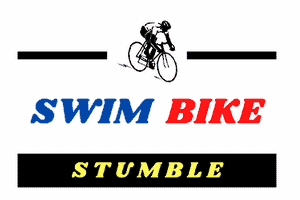With mid-May and the Sevierville Sprint Triathlon looming ever nearer, I decided to get my act together and get training while there was still time to train properly. First I picked out a training plan from Triathlete Magazine’s Essential Week-by-Week Training Guide. The plan called for two workouts in each discipline each week. After giving it some thought I added a third bike workout to each week because frankly the bike leg remains a weakness. This is a severe issue in triathlon.
Next I dusted off my used Cycleops Mag Plus trainer and set it up in the spare bedroom. I have vowed to do one to two workouts each week on the trainer. There is just no way around the time savings and the control it gives you over your bike workout. There is also no way around the boredom. So far I’ve tried watching movies on DVD, watching YouTube videos and listening to podcasts and music on my iPod. So far action movies work best for me. I find I speed up during the chase scenes. I’m still waiting for cable TV to offer the explosion channel: all explosions, all the time.
I wanted to introduce more precision into my training. I decided to address this by training using heart rate zones. Several of the fitness and triathlon podcasts I listen to regularly advocate this approach. So I Googled “heart rate zone calculator.” This was an adventure in itself. In other words, about 678,000 results (0.24 seconds). I was looking for a calculator that used both resting heart rate and age to calculate five heart rate zones. I was told that using your resting heart rate would give more accurate zones, so I took my pulse at waking for three days and used the average. I wanted five zones because this is what most of my sources – books, podcasts, websites – seem to use. Most of the sites I found calculate heart rate zones based solely on age and gave anywhere from three to seven zones. Some have zones and sub zones. Apparently it’s complicated. Anyway I found what I was looking for in the heart rate zone calculator at www.marathonguide.com.
http://www.marathonguide.com/fitnesscalcs/HeartRate2calc.cfm
Next I dug out my old Timex heart rate monitor and started wearing it during my bike and run workouts. A quick shout out to the guy on the Beginner Triathlon forum that shipped me his old heart rate strap to replace my broken strap. You sir are a gentleman and a scholar. If you are doing triathlons and aren’t browsing and posting questions on the Beginner Triathlete and Slowtwitch forums, you need to start. By monitoring my heart rate, I’m trying to introduce some precision into my training. The goal is to make my easy workouts easy and my hard workouts hard. This I’m told could lead to progress.
In another move toward more precision, I replaced my Sigma 1609 wireless bike computer with the wired version of the Sigma 1609. The wireless version was a little slow to update both speed and cadence. The lag wasn’t much, just a few seconds but it bugged me. This may have been because of interference from my Planet Bike Blaze one-watt LED headlight which is always set in strobe mode. The flashing headlight and taillight on my bike are part of my never-ending quest to avoid having my bike and I becoming a hood ornament or ditch strainer. The good news: a 30 minute test ride confirmed that the wired version updates much faster, indeed almost instantly. The bad news: I may have added a half pound to my bike in zip ties alone. When you get down on the floor and look at it, there are an amazing number of gadgets and rotating masses that you don’t want your bike computer cable to tangle with literally.

YouTube Video on Ultra Light Bike Mirror
Yet another tweak was forced upon me in the form of an ear infection. This necessitated a visit to the doctor, antibiotics, a layoff in swimming and the purchase of TYR silicone ear plugs. I’m told using either a 50/50 mix of rubbing alcohol and vinegar, or over-the-counter swimmers ear drops post swim helps also.
If you’re getting the idea that the tweaks never stop, that training and progressing is a matter of constantly adapting to changing conditions, changing equipment and changing fitness levels, then welcome to endurance sports in general and triathlon in particular. Stumble on.

